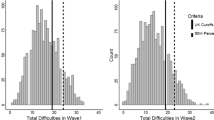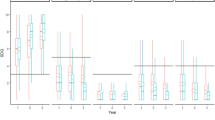Abstract
Little is known about behavioural and emotional adjustment in children in Sri Lanka, and this study is the first attempt to assess mental health problems in this population. Using the Strengths and Difficulties Questionnaire (Goodman R (1994) A modified version of the Rutter parent questionnaire including items on children’s strenghts: a research note. J Child Psychol Psychiatry 35:1483–1494) with parent, teacher and child informants, in a large sample of 10- to 13-year-old school children from Colombo, we found rates and types of problems consistent with other international studies of child mental health. Problem rates were higher in boys and were associated with lower SES and poorer academic performance. Relationships between behavioural adjustment and Tamil ethnicity and Hindu religion emerged in this sample and could possibly be associated with the experience of longstanding ethnic conflict in Sri Lanka. The study confirms the need for development of child and adolescent health services in Sri Lanka.
Similar content being viewed by others
References
Achenbach TM, Edelbrock CS (1987) Manual for the youth self-report and profile. University of Vermont, Department of Psychiatry, Burlington
Achenbach TM, McConaughy SH, Howell CT (1987) Child/adolescent behavioural and emotional problems: implications of cross-informant correlations for situational specificity. Psychol Bull 101:213–232
Bhakta P, Hackett R, Hackett L (2002) The prevalence and associations of reading difficulties in a population of South Indian children. J Res Read 25:191–202
Boney-McCoy S, Finkelhor D (1995) Psychosocial sequelae of violent victimisation in a national youth sample. J Consult Clin Psychol 63:726–736
Cohen J (1992) A power primer. Psychol Bull 112(1):155–159
Crijnen A, Achenbach T, Verhulst F (1997) Comparisons of problems reported by parents of children in 12 cultures: total problems, externalising, and internalising. J Am Acad Child Adolesc Psych 36:1269–1277
de Silva CR (1987) Sri Lanka: a history. Vikas Publishing House Pvt. Ltd., New Delhi
Edelbrock C, Costello AJ, Dulcan MK, Conover NC, Kalas R (1986) Parent–child agreement on child psychiatric symptoms assessed via structured interview. J Child Psychol Psychiatry 27:181–190
Fallon T, Schwab-Stone M (1994) Determinants of reliability in psychiatric surveys of children aged 6–12. J Child Psychol Psychiatry 35:1391–1408
Fox N, Leavitt L (1993) The psychological effects of war and violence on children. Lawrence Erlbaum Associates, Hillsdale, NJ
Freeman LN, Mokros H, Poznanski EO (1993) Violent events reported by normal urban school-aged children: characteristics and depression correlates. J Am Acad Child Adolesc Psych 32:419–423
Goodman R (1994) A modified version of the Rutter parent questionnaire including items on children’s strenghts: a research note. J Child Psychol Psychiatry 35:1483–1494
Goodman R (1997) The Strengths and Difficulties Questionnaire: a research note. J Child Psychol Psychiatry 38:581–596
Goodman R (1999) The extended version of the Strengths and Difficulties Questionnaire as a guide to child psychiatric caseness and consequent burden. J Child Psychol Psychiatry 40:791–801
Goodman R (2002a) Retrieved on 2002, March 20. SDQ information website. Retrieved from http://www.sdqinfo.com/ScoreSheets/e1.pdf
Goodman R (2002b) Retrieved on 2002, March 20. SDQ information website. Retrieved from http://www.sdqinfo.com/ScoreSheets/e2.pdf
Goodman R, Scott S (1999) Comparing the Strengths and Difficulties Questionnaire and the Child Behaviour Checklist: is small beautiful? J Abnorm Child Psychol 27(1):17–24
Goodman R, Renfrew D, Mullick M (2000) Predicting type of psychiatric disorder from Strengths and Difficulties Questionnaire (SDQ) scores in child mental health clinics in London and Dhaka. Eur Child Adolesc Psychiatry 9:129–134
Hackett R, Hackett L, Bhakta P, Gowers S (1999) The prevalence and associations of psychiatric disorder in children in Kerala, South India. J Child Psychol Psychiatry 40(5):801–807
Herjanic B, Reich W (1997) Development of a structured psychiatric interview for children: agreement between child and parent on individual symptoms. J Abnorm Child Psychol 25:21–31
Klasen H, Woerner W, Wolke D, Meyer R, Overmeyer S, Kaschnitz W, Rothenberger A, Goodman R (2000) Comparing the German versions of the Strengths and Difficulties Questionnaire (SDQ-Deu) and the Child Behaviour Checklist. Eur Child Adolesc Psychiatry 9:271–276
Koskelainen M, Sourander A, Kaljonen A (2000) The Strengths and Difficulties Questionnaire among Finnish school-aged children and adolescents. Eur Child Adolesc Psychiatry 9:277–284
Loeber R, Green SM, Lahey BB, Stouthamer-Loeber M (1991) Differences and similarities between children, mothers, and teachers as informants on disruptive child behaviour. J Abnorm Child Psychol 19(1):75–95
Maughan B (1995) Long term outcomes of developmental reading problems. J Child Psychol Psychiatry 36(3):357–371
Melzer H, Garward R, Goodman R, Ford F (2000) Mental health of children and adolescents in Great Britain: the Stationary Office, London
Mullick M, Goodman R (2001) Questionnaire screening for mental health problems in Bangladeshi children: a preliminary study. Soc Psychiatry Psychiatr Epidemiol 36(2):94–99
Offord DR, Boyle MH, Szatmari P, Rae-Grant NI, Links PS, Cadman DT, Byles JA, Crawford JW, Blum HM, Byrne C, Thomas H, Woodward CA (1987) Ontario Child Health Study II. Six-month prevalence of disorder and rates of service utilisation. Arch Gen Psychiatry 44:823–836
Patterson GR, DeBaryshe D, Ramsey E (1989) A developmental perspective on antisocial behaviour. Am Psychol 44(2):329–335
Patterson GR, Reid JB, Dishion JD (1992) Antisocial boys. Castalia Publishing Company, Eugene, OR
Prior M, Sanson A, Smart D, Oberklaid F (1999) Psychological disorders and their correlates in an Australian community sample of preadolescent children. J Child Psychol Psychiatry 40(4):563–580
Sawyer MG, Arney FM, Baghurst PA, Clark JJ, Graetz BW, Kosky Rl J, Nurcombe B, Patton GC, Prior MR, Raphael B, Rey J, Whaites LC, Zubrick SR (2000) The mental health of young people in Australia: child and adolescent component of the national survey of mental health and wellbeing. Mental Health and Special Programs Branch, Commonwealth of Australia, Canberra
Schwab-Stone ME, Ayers TS, Kasprow W (1995) Exposure to violence among inner-city youth. J Adolesc Health 14:214–219
Shenoy J, Kapur M, Kaliaperumal V (1998) Psychological disturbance among 5 to 8 year-old children: a study from India. Soc Psychiatry Psychiatr Epidemiol 33:66–73
Velez CN, Johnson J, Cohen P (1989) A longitudinal analysis of selected risk factors of childhood psychopathology. J Am Acad Child Adolesc Psych 28:861–864
Virasinghe S (2002) An exploratory study to determine behavioural adjustment in school-aged children in Sri Lanka. Doctor of Psychology thesis: Department of Psychology, University of Melbourne
Weisz JR, Sigman M, Weiss B, Mosk J (1993) Parent reports of behavioural and emotional problems among children in Kenya, Thailand, and the United States. Child Dev 64:98–109
Acknowledgements
The authors wish to acknowledge the support of Professor Robert Goodman in developing the Singhalese version of his questionnaire and early comments on the study from Professor Bill Yule.
Author information
Authors and Affiliations
Corresponding author
Rights and permissions
About this article
Cite this article
Prior, M., Virasinghe, S. & Smart, D. Behavioural problems in Sri Lankan schoolchildren. Soc Psychiat Epidemiol 40, 654–662 (2005). https://doi.org/10.1007/s00127-005-0942-x
Received:
Accepted:
Published:
Issue Date:
DOI: https://doi.org/10.1007/s00127-005-0942-x




